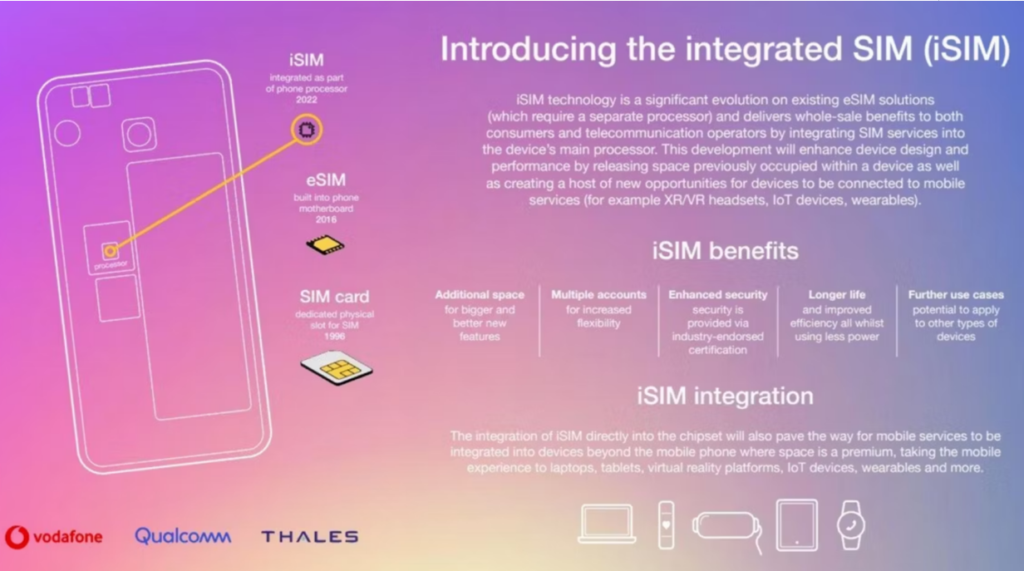Over 30 years ago, the first SIM card was invented, revolutionizing the industry.
Being able to move an existing subscription between different devices hadn’t been possible up until then – it gave customers a greater sense of control and flexibility.
Over the years, the size of SIMs became smaller – but the biggest milestone came in 2014 with the introduction of the eSIM for M2M and 2 years later for consumer electronics.
What is eSIM technology?
In short, eSIMs are embedded SIMs built into the device. They provide easier connectivity and by removing the need for a SIM card slot it saves valuable space – bringing with it many advantages for the consumer – including:
- Greater choice and flexibility: eSIM functionality means that consumers can store multiple operator profiles on a single device simultaneously, and switch between them as needed. Manufacturers and operators can now enable consumers to select the operator of their choice and then securely download that operator’s mobile subscription to any device. This undoubtedly gives consumers greater choice and flexibility and can make it easier to stay connected when travelling abroad.
- Easier sign-up: people want to buy consumer devices online and sign up to new mobile packages from home – this is even truer since the start of the pandemic. The eSIM, linked with an instant activation service, satisfies the needs of today’s consumers for immediate access to new services as it provides high level of flexibility to manage cellular connectivity along the life cycle of connected devices. This can all be done from an app which can also handle the wider digital customer on boarding (eKYC) including the required identity checks.
- Smaller design, more features: removing the need for a physical SIM card and its tray opens possibilities for manufacturers to enhance features on a device – such as a bigger battery – or create more discrete wearables. The removal of a physical SIM could also decrease the risk of water or dust damage, due to fewer holes in the device
Alongside the benefits for consumers, eSIMs are increasingly adapted to addressing many of the pain points facing IoT deployments. eSIM technology service providers have the opportunity to simplify IoT device activation while saving costs and time.
Introducing the iSIM
iSIM (Integrated SIM) is the next big step in SIM technology. It offers up the same benefits as an eSIM solution, but takes up even less space. It’s integrated into the cellular chipset which is typically combined within the application process of smartphones.
This development will enhance device design and performance by releasing space previously occupied within a device as well as creating a host of new opportunities for devices to be connected to mobile services. The integration of iSIM directly into the chipset will also pave the way for mobile services to be integrated into devices beyond the mobile phone where space is a premium, taking the mobile experience to laptops, tablets, virtual reality platforms, IoT devices and wearables.
Delivering the world’s first iSIM smartphone
We recently partnered with Vodafone and Qualcomm Technologies, Inc. to demonstrate a working smartphone featuring iSIM (based on the ieUICC GSMA specification). This milestone paves the way for commercialization of the technology, which could be rolled out in a host of new devices.
We delivered a proof-of-concept demo earlier this year, illustrating the technology’s commercial readiness and efficiency working on existing infrastructure, and leveraging Vodafone’s advanced network capabilities. In the demonstration, the fully operational proof of concept device used on Vodafone’s network was based on the Samsung Galaxy Z Flip3 5G powered by a Snapdragon® 888 5G Mobile Platform, which features a built-in Qualcomm® Secure Processing Unit running the Thales iSIM operating system.
Latest industry estimates that 30% of IoT devices supporting RSP will use iSIM by 2026, with 15% of consumer devices using iSIM by the same time.
There’s no denying the iSIM is the next significant step in SIM technology, and in our next blog we’ll be exploring this technology, and how it builds on eSIM functionality, in greater detail.
For further reading please check out the below:




